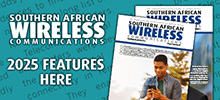15 December 2022

Martin Jarrold, vice president international programme development, GVF
In my previous column in this publication, I referenced Africa’s aggregate space economy being small (it is about 4% of the global space economy) and relatively young; but as more countries fulfil their ambition to join the club of space faring nations, the continent’s space economy forecast is for one of significant growth.
Currently, 15 African nations have launched satellites to space – 10 of these are sub-Saharan countries (Angola (satellite lost after four months in orbit), Ethiopia, Ghana, Kenya, Mauritius, Nigeria, Rwanda, South Africa, Uganda, and Zimbabwe], and five are in the north of the continent (Algeria, Egypt, Morocco, Sudan, and Tunisia). In aggregate, these nations have approximately 40 satellites in orbit, serving the following main applications (available data): telecoms (eight satellites), Earth observation (24 satellites), education & technology (eight satellites). Research predicts that a further 10 African countries will have a total of about 125 satellites in orbit by 2025, at which time the continent’s space economy will have reached US$23 billion, up from US$19.4 billion as at the end of 2021.
Prior to writing this column I had finalised the latest version of GVF’s fortnightly membership newsletter, ‘GVF FOCUS.’ One of the newsletter’s items of GVF Member News noted that the low Earth orbit (LEO) satellite operator, and GVF member, OneWeb had announced a distribution partner agreement with an Africa-based specialist technology company that supplies connectivity solutions to ‘off-grid’ locations through its satellite broadband service, Twoobii. The OneWeb LEO satellite network will give Twoobii users access to high-speed, low-latency broadband connecting even the most rural and remote communities across countries including South Africa, Lesotho, eSwatini, Namibia, Botswana, Zimbabwe, Zambia, Malawi, and Mozambique. The service will provide vital internet service and WiFi backhaul to connect schools, hospitals, civil government and other fixed enterprise and fintech services throughout the continent including banking, mining, and backhaul solutions.
An example of a Twoobii application is telemedicine for healthcare professionals. Telemedicine uses communications technology to connect patients, clinicians, and remote diagnostic equipment. The COVID-19 pandemic highlighted weaknesses in healthcare provision infrastructure in many countries, with populations in rural areas located far from clinical facilities. Modern technology offers access to needed medical advice and care cheaply and quickly, however, with a lack of terrestrial communications coverage – i.e., absence of mobile and fibre – in the regions in greatest need of telemedical coverage only smart satellite services offer the necessary speed and bandwidth to support seamless video and voice calls while offering other forms of specialist communication required for the clinicians to be able to interact with, and diagnose, patients.
Despite a quiet year with only one launch in 2020, satellite is becoming a more permanent feature on Africa’s investment horizons. Tunisia launched its Simba satellite in 2021. Challenge One, supporting IoT applications, was not the only African satellite aboard the Soyuz launcher that day, with Kenya’s Simba nanosatellite lofted in tandem, with a mission dedicated to observing wildlife in Kenya’s natural parks. Mauritius’ Earth observation MirSat-1 satellite was also launched in 2021.
This year, 2022, has seen Uganda’s first satellite, with ZimSat-1 placed into orbit from the International Space Station (ISS) with a mission to monitor weather and disasters, map the country’s mineral wealth and generate other significant data streams. Zimbabwe’s ZimSat-1 was similarly orbited from the ISS.
More African satellites are to be launched in 2023. Botswana’s first satellite programme, Bot-Sat-1, was started in December 2020. The satellite will be utilised to generate valuable data to solve developmental challenges in the communications, internet, weather forecasting, agricultural, land resources mapping, television broadcasting, and tourism, which will be the backbone of the knowledge economy within Vision 2036 and the ‘Reset Agenda’ of Botswana. Zimbabwe is preparing to launch its second satellite in 2023, ZimSat-2, a communications satellite which will enable total national connectivity, making ICT and other communication applications pervasive in national development.
Kenya’s Simba nanosatellite is an example of the importance for African countries’ satellite programmes of the development of CubeSat technology. With CubeSats – smaller, lighter, and easy to design – the African satellite market is increasingly open, based on ‘democratisation’ of the manufacturing process.
Of course, no African country has its own launch capacity, and most African-owned satellites are still designed abroad, but there is underway a process of change and transition which means that the continent is definitely in the new ‘space race.’ Assets in space are much more than an exercise in national vanity or international rivalry. Owning a satellite is now a strategic necessity, for both economic and social development. The scale of the range of applications which can be served by satellite has already been partially illustrated above and encompasses meteorology, natural resource management, navigation, and surveillance as well as the telecommunications on which services such as the Twoobii-based telemedicine depend.
Connecting schools is another example of where there is a satellite imperative. One project to connect schools in fact engages both satellite communications and Earth observation (EO). ‘Giga’ is a joint initiative of UNICEF and the ITU – combining UNICEF’s ‘experience in education and procurement, ITU’s expertise in regulation and policy, and the private sector’s ability to rapidly deploy technology solutions’ – to connect every school in the world to the internet by 2030.
Connecting schools allows children to develop digital skills and access online learning. Schools can become anchor points for surrounding communities, such that if you connect a school, you can connect local businesses and services. ‘Giga’ is advancing school connectivity with a combination of EO and an AI algorithm which can recognise such surface features as school-type buildings and football pitches. With information on school locations across remote regions being collected and collated, there is introduced an efficient and further first step in bridging the digital divide.






